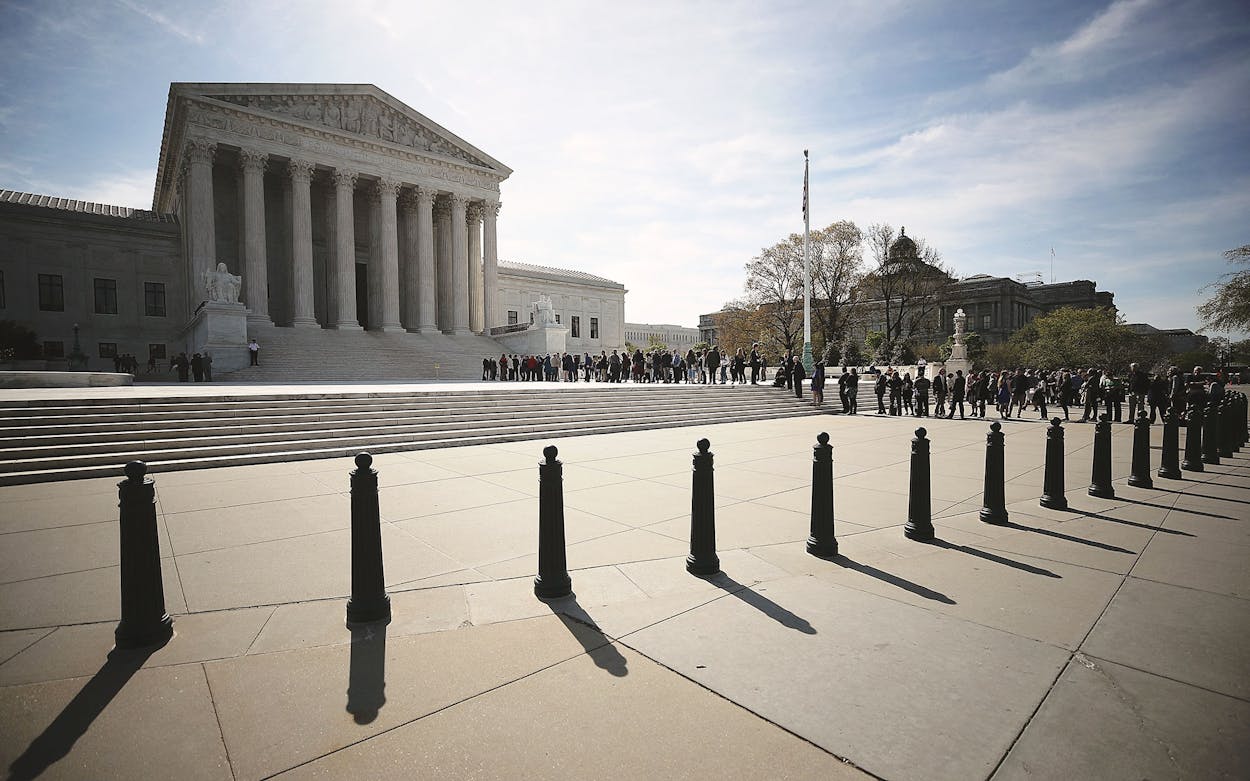Every decade after data from the U.S. Census is released, the Texas legislature creates new legislative and congressional districts based on changes in the state’s demographics. How the boundaries of those district maps are drawn can determine which political party—and sometimes which politician—will win the district. This practice, called redistricting and employed by virtually every legislature in every state, has drawn the eye of the U.S. Supreme Court this year. So when a three-judge federal court in San Antonio last year described the latest redistricting effort as an illegal ruse that threatened minority voting rights, Governor Greg Abbott and Attorney General Ken Paxton appealed to the high court. Oral arguments in the case are scheduled to be heard Tuesday by the U.S. Supreme Court. Here’s what you need to know about the case:
What is gerrymandering?
Gerrymandering is the practice of manipulating political boundaries usually to give advantage to one political party or another. It’s a practice that has been going on since the founding of this country and typically happens every ten years following the release of the U.S. Census data. While the U.S. Supreme Court has shown a reluctance to enter the fray over political disputes in the past, it has recently stepped in more aggressively when minorities’ voting rights might be threatened—which is at the heart of the allegation in the Texas case.
Why is the U.S. Supreme Court hearing a Texas redistricting case?
Findings by a three-judge federal court panel that the Texas legislature discriminated against Hispanics and African Americans in drawing three congressional districts and in multiple state House districts will come up for review by the U.S. Supreme Court on Tuesday.
The case has been lingering since 2014 and may not affect state elections before 2020. However, if the Supreme Court rules against the state, new interim maps could be drawn and special elections ordered for the fall. The combined cases are known as Perez v. Abbott.
Which districts might be affected by the case?
The case could force a redrawing of the following congressional districts: District 23, held by U.S. Rep. Will Hurd, R-Helotes; District 27, held by Corpus Christi Republican Blake Farenthold until his recent resignation amid a sexual harassment controversy; and District 35, held by Democrat Lloyd Doggett of Austin. State House districts that the federal court found as discriminatory were in Bell, Bexar, Dallas, El Paso, Harris, Hidalgo, Lampasas, Nueces, and Tarrant counties. A three-judge panel in March 2017 ruled that minority voting strength was diminished in these districts in violation of the Voting Rights Act and the Fourteenth Amendment to the Constitution. CORRECTION: The three-judge panel upheld District 23 as a legal minority opportunity district after a hearing in August 2017, and the district is not part of the Supreme Court case.
What other partisan gerrymandering cases might affect Texas?
The Supreme Court is currently considering partisan gerrymandering cases out of Maryland and Wisconsin, where districts were drawn for so much political advantage that the high court may drop its traditional reluctance to address politics in redistricting. In Maryland, Democratic legislators drew a congressional district that only a Democrat could win, while Wisconsin Republicans drew a legislative map that gave two-thirds of the lower house seats to Republicans even though the aggregate vote for legislative candidates in the state was about 50-50 for each party. Political gerrymanders penalize the voters of the losing party by making their vote ineffective and make the concept of “consent of the governed” mostly moot.
The Maryland and Wisconsin cases could affect Texas because the dissenting jurist in the Texas cases—5th Circuit Court of Appeals judge Jerry Smith—said his fellow judges in the legislative case “badly overreached in finding that Texas used race, rather than partisan advantage, as the predominant factor in the 2011 redistricting.” Smith wrote that the Republican-controlled legislature looked at the party affiliation of voters rather than their race in drawing the districts. If political gerrymandering is ruled unconstitutional by the Supreme Court, the cover of discriminating against blacks and Hispanics on the basis of political leanings would be removed.
What is the history of this case?
Following the 2010 census, the Texas legislature drew new district maps for Congress, the state House, and the state Senate. A federal court ruled the congressional and House maps illegal and drew interim maps for the 2012 elections. The legislature then adopted those maps in the 2013 session. A trial was held on the legality of those maps in 2014, and the three-judge panel issued its opinion in March 2017 that the maps were illegal, at least in part.
When will the Supreme Court rule?
Most likely, Texas will not see a ruling before this summer. However, one of the issues before the court on Tuesday is whether the court has jurisdiction to hear the case at this time. Usually, the Supreme Court can only hear an appeal of a three-judge panel’s ruling if an injunction is granted or denied. In this case, the panel did neither.
Typically, the federal courts do not intervene in elections that are already in process—which the Texas elections are, because the party primaries have already been held. However, in 1996, a federal court in Vera v. Bush ordered new elections in thirteen congressional districts. There were open primaries with all candidates running on November 5, 1996, followed by a runoff in four districts on December 10.
- More About:
- Politics & Policy
- Texas Legislature
- Supreme Court






